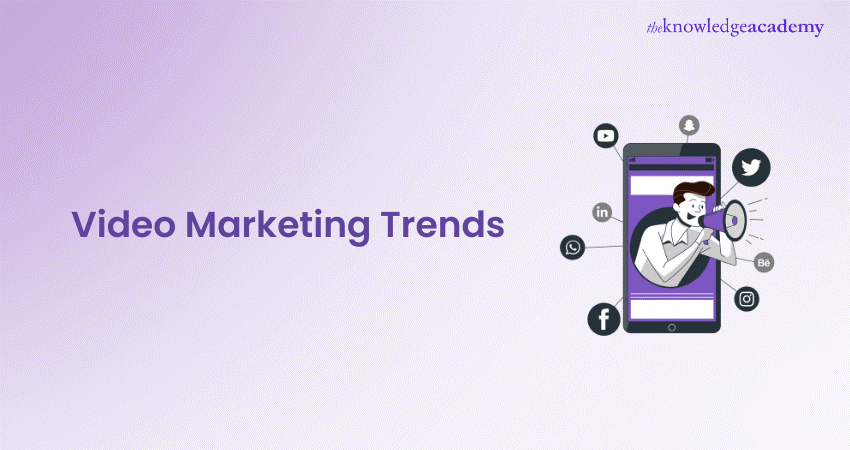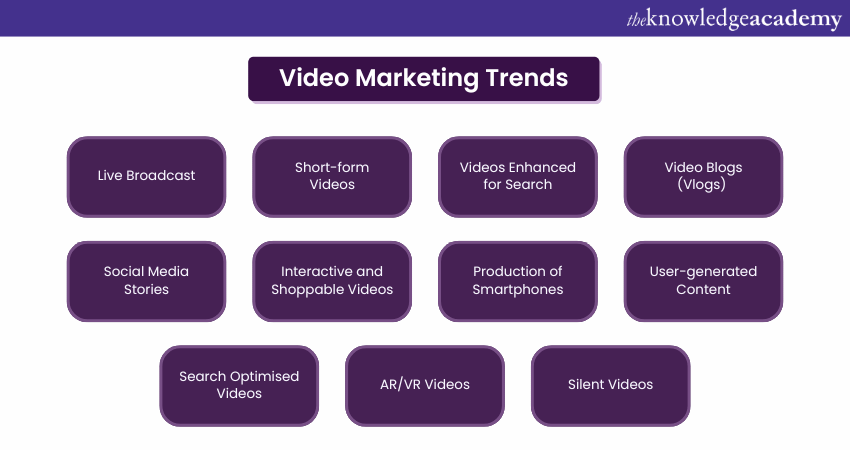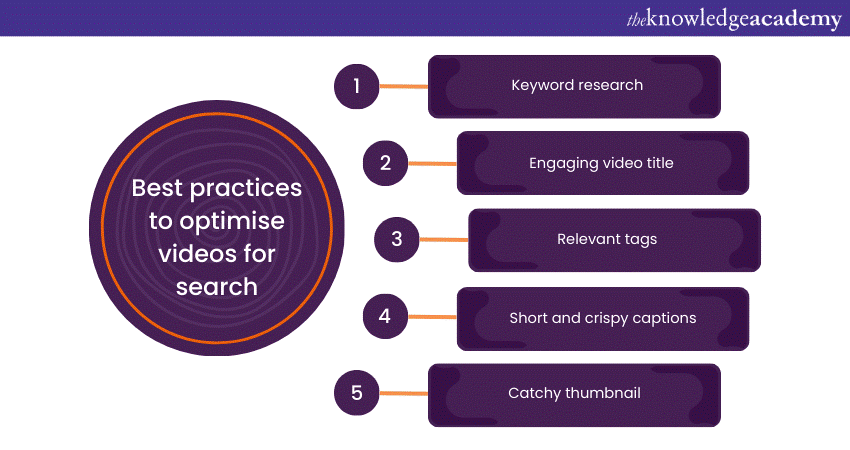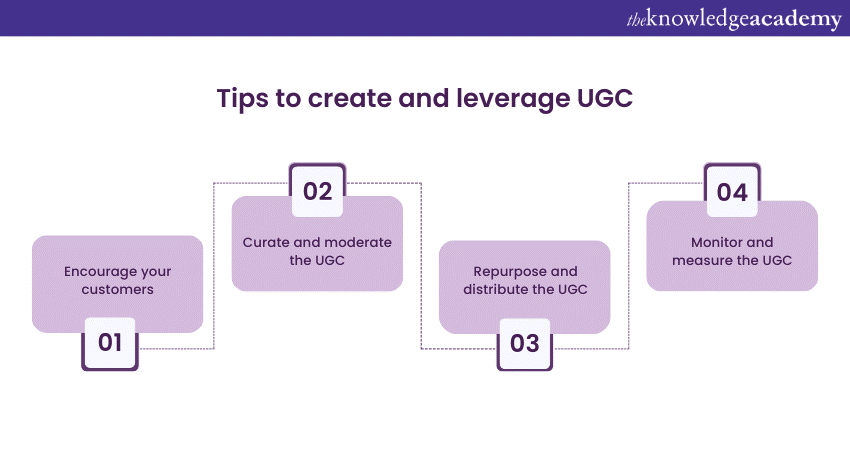We may not have the course you’re looking for. If you enquire or give us a call on +44 1344 203 999 and speak to our training experts, we may still be able to help with your training requirements.
We ensure quality, budget-alignment, and timely delivery by our expert instructors.

Video Marketing is one of the most efficient methods to reach and engage your audience, boost brand awareness, and increase conversions. However, Video Marketing is not static; you must stay updated with the latest Video Marketing Trends to maximise your video efforts.
According to Statista, ad spending in the video advertising market is projected to reach 141.5 billion GBP in 2023. In this blog, we will explore eight Video Marketing Trends you can’t afford to ignore in 2023. These trends will help you create more engaging, relevant, and compelling videos for your target audience and achieve your marketing goals.
Table of Contents
1) 11 Video Marketing Trends
a) Live broadcast
b) Short-form videos
c) Videos enhanced for search
d) Video blogs (Vlogs)
e) Interactive and shoppable videos
g) Production of smartphones
h) User-generated content
2) Conclusion
8 Video Marketing Trends
Let's explore eight Video Marketing Trends you can’t afford to ignore in 2023. These trends are:

1) Live Broadcast
Live video is not new, but it has gained more popularity and traction in recent years, especially during the pandemic. Engaging in live video lets you instantly interact with your audience, display your brand's personality, and generate a feeling of immediacy and exclusivity. Live video can be used for various purposes, such as product launches, Q&A sessions, interviews, behind-the-scenes (BTS) webinars, tutorials, and more. You can also leverage live video to interact with your viewers, answer their questions, solicit feedback, and encourage them to act.
As per a Livestream and New York Magazine survey, 80% of those surveyed would choose to watch live videos from a brand over reading a blog, and 82% favour live videos from a brand compared to social media posts. Moreover, live videos can generate more engagement, reach, and organic traffic than recorded videos, as most social media platforms prioritise live content in their algorithms.
To make the most of live video, plan, choose the right platform, promote your live event, prepare your equipment and script, and test your connection and sound. You must also be authentic, spontaneous, and responsive during your live broadcast and follow up with your audience after the event. That’s one surefire way to align yourself with evolving Video Marketing Trends.
2) Short-form Videos
Short-form videos have been among the most effective Video marketing Trends for a while. These videos are typically less than 60 seconds long and often as short as 15 seconds or less. For B2B Video Marketing, short-form videos are designed to capture the viewers' attention and deliver a clear and concise message in a short time span.
Short-form videos work well on social media platforms like Instagram, TikTok, Snapchat, and YouTube Shorts, where users have limited attention spans and intense competition. Short-form videos can help you increase your brand awareness, reach new audiences, and drive more engagement and traffic to your website.
To create compelling short-form videos, you must have a clear goal, a catchy hook, a simple and focused story, and a solid call-to-action (CTA). You also need to optimise your videos for each platform, using the correct format, aspect ratio, length, captions, hashtags, and keywords.
Some examples of short-form videos are teasers, trailers, tips, testimonials, challenges, memes, and user-generated content.
3) Videos Enhanced for Search
Search Engine Optimisation (SEO) isn't limited to text-based content; it also applies to Video Marketing Trends . SEO strategies can enhance your ranking on search engines like Google and Bing, leading to increased organic traffic to your website and videos. To optimise your videos for search, you need to follow some best practices, such as:

a) Conduct keyword research and use relevant and popular keywords in your description, video title, tags, and captions.
b) Create high-quality and engaging videos that provide value to your audience and match their search intent.
c) Use an eye-catching and relevant thumbnail that entices the viewers to click on your video.
d) Embed your videos on your website and optimise the page for SEO using meta tags, headings, and schema markup.
e) Encourage the viewers to like, comment, share, and subscribe to your videos, as these signals can boost your ranking and visibility.
f) Measure and analyse your video performance using tools such as Google Analytics, Google Search Console, and YouTube Analytics, and make adjustments accordingly.
Amplify your online impact with our Digital Marketing Courses – sign up today!
4) Video Blogs (Vlogs)
Video blogs, or Vlogs, are videos that document your personal or professional experiences, opinions, insights, or tips on a specific topic or niche. Vlogs are similar to blogs but use video as the primary communication medium.
Creating vlogs can be instrumental in presenting your brand's personality, fostering trust and credibility, and cultivating a dedicated and engaged fan base. Vlogs can also help you generate more traffic, leads, and conversions, as they can showcase your products or services, demonstrate your expertise, and persuade your audience to take action.
To create thriving vlogs, you need to:
a) Define your target audience, niche, and goals, and create a content strategy and schedule.
b) Choose the right equipment, such as a camera, microphone, tripod, and lighting, and find a suitable location and background for your vlogs.
c) Plan your vlog content, structure, and script, and make sure it is relevant, informative, entertaining, and authentic.
d) Edit your vlog using tools such as Adobe Premiere Pro, iMovie, or Filmora, and add effects, transitions, music, and graphics to enhance your vlog quality and appeal.
e) Upload your vlog to your preferred platform, such as YouTube, Vimeo, or your own website, and optimise it for SEO using keywords, tags, descriptions, and thumbnails.
f) Promote your vlog using social media, email, and other channels, and engage with your viewers, responding to their comments, questions, and feedback.
5) Social Media Stories
Social media stories are short and brief videos that disappear after 24 hours. They are popular on platforms such as Instagram, Facebook, Snapchat, and LinkedIn, allowing you to share your daily moments, updates, and behind-the-scenes (BTS) with your followers.
Social media stories can help you increase your brand awareness, engagement, and retention, as they can create a sense of urgency, exclusivity, and intimacy with your audience. Social media stories can also help you drive more traffic, leads, and sales, as they can feature links, stickers, polls, quizzes, and other interactive elements that can encourage your viewers to take action.
To create captivating social media stories, you need to:
a) Know your audience, platform, and goal, and create a content plan and calendar.
b) Use the native features and tools of each platform, such as filters, effects, stickers, emojis, and text, to create fun and creative stories.
c) Use vertical videos, as they are more suitable for mobile devices and stories format.
d) Keep your stories short, simple, and clear, and use a hook, a story, and a call to action.
e) Post your stories regularly and consistently and monitor your story performance using analytics and insights.
6) Interactive and Shoppable Videos
Interactive and shoppable videos enable viewers to engage with the content by clicking, swiping, tapping, or hovering, allowing them to perform various actions like purchasing products, booking services, filling out forms, or participating in quizzes.
Interactive and shoppable videos can help you increase your video engagement, retention, and conversion, as they can provide a more immersive, personalised, and convenient experience for your viewers. Interactive and shoppable videos can also help you collect more data and feedback from your viewers, improving your video performance and optimisation.
To create compelling interactive and shoppable videos, you need to:
a) Define your audience, objective, and message, and create a video storyboard and script.
b) Use a video platform or tool that supports interactive and shoppable features like WIREWAX, Eko, or Spott.
c) Design your interactive and shoppable elements, such as buttons, icons, menus, or overlays, and make sure they are visible, intuitive, and relevant.
d) Test your interactive and shoppable video, and ensure it works smoothly and seamlessly on different devices and browsers.
e) Analyse your interactive and shoppable video performance and measure the metrics, such as clicks, views, conversions, and revenue.
Elevate your Twitter game with our Twitter Marketing Masterclass – sign up now!
7) Production of Smartphones
Smartphones have evolved beyond mere communication devices, now serving as potent tools for video production. They enable you to craft high-quality, professional-looking videos with minimal cost and effort. Smartphones have many advantages for video production, such as:
a) They are portable, convenient, and easy to use.
b) They have high-resolution cameras, microphones, and screens.
c) They have built-in editing and sharing features and apps.
d) They can access the internet and cloud storage.
To produce great videos with your smartphone, you need to:
a) Use a tripod or a stabiliser to keep your smartphone steady and avoid shaky footage.
b) Use external microphones or headphones to improve audio quality and reduce background noise.
c) Use artificial or natural lighting to illuminate your subject and avoid shadows and glare.
d) Use the landscape mode to capture more details and avoid black bars on the sides of your video.
e) Use the rule of thirds when framing your shots to create a well-balanced arrangement of elements.
f) Use editing apps like InShot, Quik, or KineMaster to trim, crop, rotate, and add effects, music, and text to your video.
8) User-generated Content
User-generated content (UGC) encompasses any content produced and shared by your customers, enthusiasts, or followers, including reviews, testimonials, photos, videos, or posts on social media. UGC can also help you generate more content, engagement, and conversions, as they can inspire, influence, and persuade your audience to take action.
To create and leverage UGC, you need to:

a) Encourage your customers, fans, or followers to create and share content about your brand, product, or service using incentives, contests, challenges, or hashtags.
b) Curate and moderate the UGC and select the best and most relevant content for your brand and audience.
c) Repurpose and distribute the UGC using your channels, such as your website, blog, social media, email, or video platforms, and give credit and appreciation to the original creators.
d) Monitor and measure the UGC performance and analyse the metrics, such as reach, engagement, sentiment, and conversions.
9) Search Optimised Videos
As compared to traditional SEO techniques, videos are more likely to achieve first-page rankings. To optimise your search engine results using videos, focus on these three areas:
a) Relevance: Ensure that your videos have a clear objective. Make them relevant to consumers by addressing their questions, educating them on relevant topics related to your brand, and creating engaging content.
b) Consistency: Much like traditional SEO content, consistency is crucial for improving your rankings. Make a habit of regularly creating and publishing video content on your website to boost traffic.
c) Backend Optimisation: Pay attention to technical optimisation steps such as title tags, keywords in descriptions, selecting the right thumbnail images, and responding to comments to enhance engagement.
10) AR/VR Videos
AR and VR content are gradually becoming integral to mainstream Video Marketing Trends. This is inevitable as the technology becomes more accessible and consumers look for increasingly interactive experiences. With this shift, you need to be ready to integrate AR and VR into your video marketing strategies, as traditional videos may no longer be sufficient. Consider these examples:
a) Retail stores providing virtual 'Try before you buy' deals
b) Healthcare providers using AR and VR for self-guided diagnostics
c) Educators engaging students with ARand VRpowered games and activities
d) Fintech industry creating immersive virtual bank branches for interactive financial consultations and education
Over the past few years, the public's perception of virtual experiences has significantly evolved. It's unlikely that consumers will forgo the convenience and accessibility these virtual options offer. Therefore, AR and VR are poised to become a lasting strategy for video marketers.
11) Silent Videos
While a video offers the combined advantages of image and sound, Marketers today create videos to be watched silently. If that sounds unusual, think of all the times you scroll through Facebook and an Ad pops up and plays loudly. That's a negative experience most other consumers will relate to.
It's important to remember that people watch videos on their smartphones everywhere they go—be it crowded waiting rooms, public transportation, classrooms, or even meetings.
So, if you want people to stick around and watch your video content, optimising it for silent viewing is essential. The good news is that all it takes is the simple addition of closed captions to keep consumers engaged.
Conclusion
Utilising Video Marketing is a potent and ever-changing method to engage with your audience, expand your brand, and reach your marketing objectives. By staying current with the latest Video Marketing Trends, including live streams, short-form videos, search-optimised videos, vlogs, social media stories, and interactive videos, you can craft more relevant and impactful videos. We hope this blog helps you stay informed about the ongoing trends in Video Marketing and help youdistinguish your marketing campaign
Transform your digital prowess with our SEO Course – sign up today!
Frequently Asked Questions
How video marketing can grow your business?

Video marketing can grow a business by offering a sense of Personal Connection, Transparency, Mobile Engagement and Relatability
How do you create a B2B video marketing strategy?

One can create a B2B Video Marketing strategy by setting purpose, budget, choosing video type, choosing video platform, publishing and promoting the video. This strategy will work despite any changes in Online Video Marketing Trends.
What are the Other Resources and Offers Provided by The Knowledge Academy?

The Knowledge Academy takes global learning to new heights, offering over 3,000 online courses across 490+ locations in 190+ countries. This expansive reach ensures accessibility and convenience for learners worldwide.
Alongside our diverse Online Course Catalogue, encompassing 19 major categories, we go the extra mile by providing a plethora of free educational Online Resources like News updates, Blogs, videos, webinars, and interview questions. Tailoring learning experiences further, professionals can maximise value with customisable Course Bundles of TKA.
What is The Knowledge Pass, and How Does it Work?

The Knowledge Academy’s Knowledge Pass, a prepaid voucher, adds another layer of flexibility, allowing course bookings over a 12-month period. Join us on a journey where education knows no bounds.
What are the Related Courses and Blogs Provided by The Knowledge Academy?

The Knowledge Academy offers various Marketing Courses, including Mobile Marketing and Pay Per Click (PPC) Training. These courses cater to different skill levels, providing comprehensive insights into Content Marketing.
Our Digital Marketing Blogs cover a range of topics related to Video Marketing, offering valuable resources, best practices, and industry insights. Whether you are a beginner or looking to advance your Video Marketing Skills, The Knowledge Academy's diverse courses and informative blogs have got you covered.
Upcoming Digital Marketing Resources Batches & Dates
Date
 Digital Marketing Course
Digital Marketing Course
Fri 28th Mar 2025
Fri 23rd May 2025
Fri 25th Jul 2025
Fri 26th Sep 2025
Fri 28th Nov 2025






 Top Rated Course
Top Rated Course



 If you wish to make any changes to your course, please
If you wish to make any changes to your course, please


